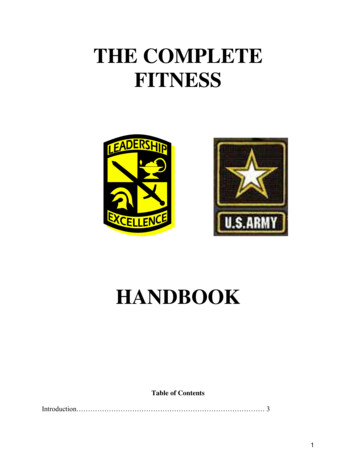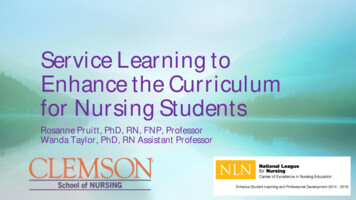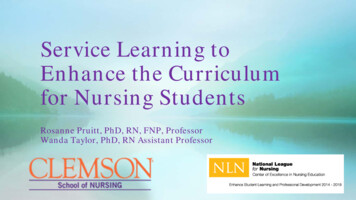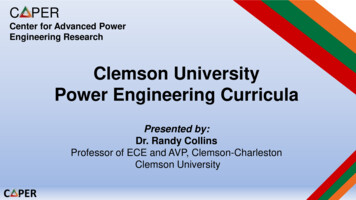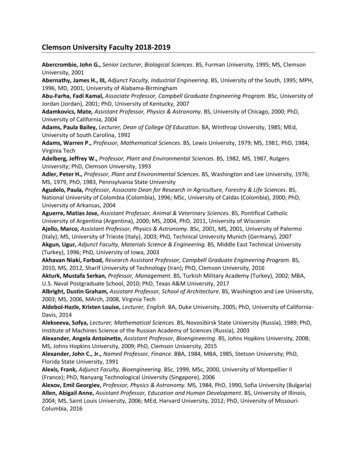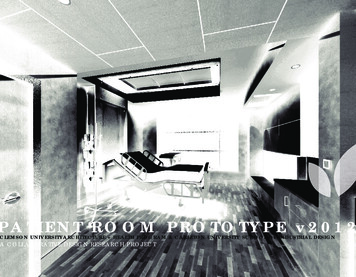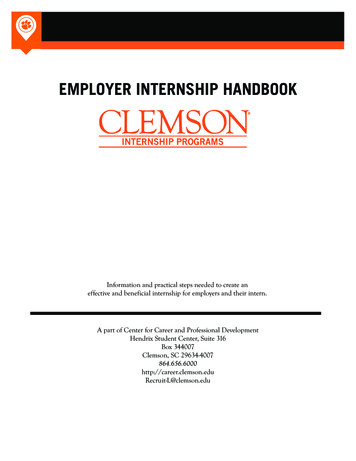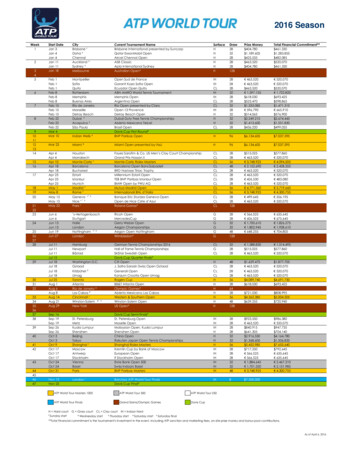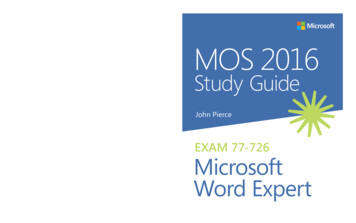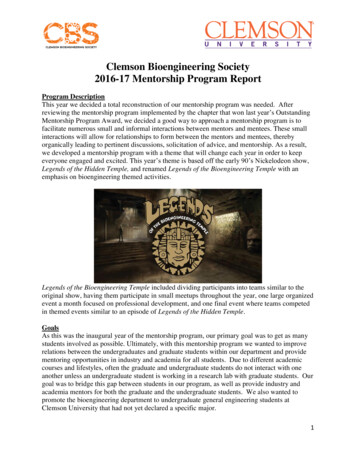
Transcription
Clemson Bioengineering Society2016-17 Mentorship Program ReportProgram DescriptionThis year we decided a total reconstruction of our mentorship program was needed. Afterreviewing the mentorship program implemented by the chapter that won last year’s OutstandingMentorship Program Award, we decided a good way to approach a mentorship program is tofacilitate numerous small and informal interactions between mentors and mentees. These smallinteractions will allow for relationships to form between the mentors and mentees, therebyorganically leading to pertinent discussions, solicitation of advice, and mentorship. As a result,we developed a mentorship program with a theme that will change each year in order to keepeveryone engaged and excited. This year’s theme is based off the early 90’s Nickelodeon show,Legends of the Hidden Temple, and renamed Legends of the Bioengineering Temple with anemphasis on bioengineering themed activities.Legends of the Bioengineering Temple included dividing participants into teams similar to theoriginal show, having them participate in small meetups throughout the year, one large organizedevent a month focused on professional development, and one final event where teams competedin themed events similar to an episode of Legends of the Hidden Temple.GoalsAs this was the inaugural year of the mentorship program, our primary goal was to get as manystudents involved as possible. Ultimately, with this mentorship program we wanted to improverelations between the undergraduates and graduate students within our department and providementoring opportunities in industry and academia for all students. Due to different academiccourses and lifestyles, often the graduate and undergraduate students do not interact with oneanother unless an undergraduate student is working in a research lab with graduate students. Ourgoal was to bridge this gap between students in our program, as well as provide industry andacademia mentors for both the graduate and the undergraduate students. We also wanted topromote the bioengineering department to undergraduate general engineering students atClemson University that had not yet declared a specific major.1
Target AudienceThe mentorship program was formally proposed to all members of the BMES Clemson studentchapter, including members of the Clemson Bioengineering Society, CBS (composed of onlygraduate students), and members of the Undergraduate Clemson Bioengineering Society, UCBS(open to all undergraduates in the Bioengineering Department). Although this mentorshipprogram was organized by the BMES student chapter, we did not want to isolate this mentoringopportunity to those students alone, so we invited members to reach out to other students withinthe department that weren’t involved in the student chapter or any younger students that werestill unsure about declaring bioengineering as their major. To promote the program to graduatestudents, a focus on industry relations and future academic careers was placed in several of theorganized events. To appeal to the undergraduates, the offer of industry advice from theseevents as well as advice about future graduate school plans from current graduate students wasoffered.Chapter Participation26 graduate students and 28 undergraduate students participated in the program along with 3mentors that were not participating as mentees (one undergraduate senior, one 4th year PhDstudent, and one post-doc). These 54 participants were then sorted into one of five teams basedon either their research (if they were a graduate student or undergraduate researcher) or justbased off their interest in the topic. These groups were based off the academic tracks available tostudents in the bioengineering department curriculum at Clemson – biomaterials, regenerativemedicine, bioelectrical, and biomechanics. Since we have a very strong presence in some topicsand less so in other topics, the teams were divided as follows:1. Biomaterials2. Regenerative Medicine 13. Regenerative Medicine 24. Regenerative Medicine 3 & Bioelectrical5. BiomechanicsOne of the rules for participation throughout the year, which will be detailed later in this report,was that in order to get credit for an event, at least 3 members of each team must be present andthere must be at least 1 undergraduate and 1 graduate student present. This was to reinforce ourgoal to promote collaboration and conversations between the undergraduate and graduate groups.In addition, to get credit for the program and receive points in order to win prizes at the end ofthe semester, all students were required to have participated in at least one of the main events.Methods (including time commitment and budget)Semester Activities Planning (1-2 hours, 0)The CBS mentorship chair met with the officers of UCBS to learn what the undergraduatestudents would want most from a mentorship program, both from the graduate students they’d bepartnered with and from industry and academic outside mentors. Together they coordinated aschedule and budget. It was agreed that a monthly organized event would be ideal, UCBS fundswould cover food, which would be present at each main event, and that CBS funds would covermaterials for the program and prizes at the end.2
Proposal of new mentorship program to the department (10 min, 0)Mentorship chairs proposed the concept at the first CBS and UCBS meetings of the semester andprovided sign-up sheets. Interested students were contacted and invited to the intro night.Introduction Night (1.5 hours, 50)The theme was further introduced and we watched an episode of Legends of the Hidden Templeso that anyone unfamiliar with the show would understand the setup and get excited aboutjoining their team. The setup of the program was introduced: Everyone has been placed on a team by the leaders of the program (divided as previouslymentioned) based off their research topics or interests Teams created logos representing their bioengineering-themed names Everyone is invited to join the Facebook page for this year’s mentorship program There is a point system for attending events with your team throughout the program—main events count for more points, and there is a standing invitation to gain points foryour team if you go get coffee, ice cream, lunch, etc. together at any point. The onlyrules are that there must be at least 3 team members present, and at least one must be anundergraduate and at least one must be a graduate student. For points to be awarded, apicture of those that attended must be posted to the Facebook group page. Additionalevents throughout the semester counted for points such as other BMES student chapterevents, including social events and professional development events. Prizes at the end will be given to everyone who participates, however the team that winsthe final event gets a larger prize and the team that gets the most points throughout theyear gets a grand prize.3
Newlyweds Night (1.5 hours, 190)Each team took the logo design from the Intro Night and painted them on team t-shirts (eachteam was also assigned a color, which corresponded with the color of their team shirt). Whilemaking their shirts and eating pizza, teams socialized in order to learn facts about each other.After the shirts were done, teams competed against each in the Newlyweds game. For the gameteams sent a teammate to the front of the room and a question was asked about that person and ifthe team got the answer correct, they got a point. The intention was to fast-track personaldiscussions so that teams would learn more about each other, and talking points for futureinteractions.Main Monthly Events Kickoff event (time commitment and budget listed above)This event is the Introduction Night described above. The setup and point system of theprogram were explained and any questions about mentoring were answered. Teams weredivided by research interest and each group chose a color and developed team names.The names were similar to the teams from the original Legends of the BioengineeringTemple, however with a bioengineering spin relating to their research/interest topics. Forexample, Purple Parrots, Silver Snakes, Orange Iguanas, and Green Monkeys were allteam names in the original show. In our event, teams chose to be the OrangeOrthopaedics, Purple Pipettes, Silver Stents, Green Growth Factors, and Blue Brains.4
Teams then took pizza boxes anddrew logos on them that were cutout like stencils and later used tomake team shirts. Students wereencouraged to wear their teamshirts for any events, especially thefinal event.5
Freshman Expo/Lab Demonstrations (2.5 hours, 0)To expand mentorship outside of the bioengineering department, we hosted a labdemonstration night for general engineering students interested in bioengineering. Due toClemson’s engineering curriculum, all incoming freshmen interested in engineering muststay as general engineering majors for their freshman year, then they can declare a morespecific engineering major for sophomore year. The general engineering program used torequire students to tour 3 departments during their freshman year, but since thisrequirement has been lifted, many freshmen don’t get to explore the different engineeringdepartments at Clemson in order to determine the different things each department has tooffer. We extended an invitation to all students (by making announcements in thegeneral engineering classes and emailing the undergraduate student body) to come to thisevent and learn more about bioengineering and what makes it such a unique engineeringfield. The event had two main parts:1. Tours led by senior Alison Markley provided an overview of the curriculumrequired by undergraduates in the department followed by a tour of theundergraduate research spaces and teaching labs.2. Lab demonstrations by 10 different research labs in the department, led by graduatestudents and one undergraduate creative inquiry group. These demonstrationshelped exhibit that the bioengineering department has a variety of research interestsranging from cell biomechanics to tissue engineering, magnetic nanoparticles,robotics, and human biomechanics. Students signed their names on an interestsheet along with the labs they were interested in. Following the event, students wereput in contact with the associated professors to initiate communication betweenstudents and professors and to help them get involved in the lab.6
Career Track Night (2 hours, 50)Partnering with our BMES student chapter professional development committee, wehosted a night targeted at mentoring all students who attended. Career track night startedwith an introduction of the mentors from industry, co-ops and internships, and academia.Mentors were split into groups depending on their backgrounds. Industry was representedby former or current employees of: The BioMotion Foundation of Florida, PolyMed, andStryker Orthobiologics Division. Students with an interest in going into industry wereable to discuss work style, hiring methods, and the pros and cons of larger companiesversus startups. Co-ops and internships were represented by undergraduate and graduatestudents who had previously worked at: Halyard Health, W. L. Gore & Associates,BASF, and Johnson & Johnson. They were able to help with intern and co-op relatedquestions, how to balance co-ops and school, how to best apply, and more. Academia wasrepresented by two current professors in the Clemson University BioengineeringDepartment, Dr. Melinda Harman and Dr. Jeremy Mercuri, both of whom also haveprevious industry experience. In addition, the graduate student services coordinator forthe Bioengineering Department attended to critique resumes and help answer anyquestions about applying to and attending graduate school.Final Event (2.5 hours, 100)For those that are not familiar with the show Legends of the Hidden Temple, there arefour stages in each episode: The Moat, the Steps of Knowledge, the Temple Games, andthe Temple Run. Each of these stages were replicated in the final event, in essence thefinal event for the mentorship program was an episode of Legends of the BioengineeringTemple. Teams were not divided according to the team they had been in all year, butrather teams were divided evenly based on the number of people that could attend thefinal event. This allowed for collaboration between students that may not have interactedthroughout the mentorship program previously. The event was split as follows:o The Moat (an event “in” water):Each team member was given a cup and told to stand in a line one in front of theother. The object of the Moat race was for each team to get from the start line tothe finish line by pouring the contents of their cup of water backwards over theirheads and into their teammate’s cup. Then the person who just passed the waterran to the back of the line. The team with the most water at the end of the race gota point and the team that finished the race first got a point.o The Steps of Knowledge:The final event organizer wrote a story about the “Legend of the Clemson Hip”—a hip prosthesis coating patented out of the Clemson Bioengineering departmentthat profited commercially. Like in the show, the teams had to listen to the storyand then be first to answer questions related to the information they just received.The first two teams to make it to the bottom step received a point each.o The Temple GamesThe Temple Games consist of three 60-second games completed by each team orselected members of each team. They included: M&M pickup—teams worked together to move as many M&M’s aspossible from one plate to another by sucking them up with a straw7
Mini Marshmallow Toss—teams chose partners to toss minimarshmallows to their partner’s cup Cookie Face Challenge—teams chose 2 people to try and move a cookiefrom their forehead to their mouth without the use of their hands8
o The Temple Run:Teams were given scavenger hunt clues that sent them all over campus. This wasa great opportunity for the undergraduate students to mentor the graduate studentsas many of the undergraduate students are more familiar with Clemson’s campusand the history behind the monuments, businesses, and buildings.Assessment of how goals were achievedAfter the final event of the semester, a survey was sent out to the members of this year’smentorship program participants. The survey asked for feedback on what students liked about theprogram, what they didn’t, and ways to improve. These survey responses are being consideredin the design of next year’s programs. Since this was the first year of the program, the mainsource of assessment was numbers of participants in the events, followed by the end-of-yearsurvey gauging thoughts on the year. For future programs, retention rates from program toprogram as well as within the semester will be monitored.Future of ProgramAt the end of the final event, the theme for the next semester was announced via the prize for thewinning team—a Power Ranger piñata. The fall 2017 theme will be Power Rangers which wehave decided is ideal for the setup of the program because it is a well-known show with an easy9
division of teams via color. As for improvements for next year, the survey provided a goodinsight into how participants felt about the program. So far, positive responses to this style ofmentorship program have included: “Undergrads getting to know the grad students and vice versa” “Increased informal interaction between the two groups” “Fun activities” “A fun final event to finish the year off”Recommended improvements provided us with meaningful changes to be implemented nextyear. It was recommended to: “Increase awareness of the program to the undergraduates in the department, which isunderstandable since the main coordinator was a graduate student and they did not knowhow to reach out to the undergraduates as well.” “Vary the event days.” This response is a reflection of a common problem many of theBMES student chapters face—how to find a time when both the graduate andundergraduate students can meet. We have found in our chapter that on average theundergraduates prefer to meet at night and the graduate students want to go home after afull day in lab. To address this problem, we often hosted events after CBS meetings,which take place after graduate student seminar, a required course for all graduatestudents. This guaranteed that the graduate students were still on campus late. However,the graduate student seminar only takes place on Mondays so if a student was unable toattend on Monday nights, they were unable to attend many events. Students liked some of our larger informal events (like the Newlyweds night) a lot andwanted more similar events.Moving forward, we hope to continue our mentorship program each semester with the intentionthat students will become more comfortable interacting with one another outside an academicsetting. We believe that developing these interactions between graduate and undergraduatestudents will improve mentorship as well as the relationships between students in research labsand within the bioengineering department. Becoming more comfortable talking with mentorstakes away the perceived barrier between mentors and mentees when questions do arise forwhich they could use advice. Also, we hope to see not only the mentor/mentee relationshipsdevelop while in school, but also lasting relationships that continue on into industry and/oracademic careers. We hope that in the future the success of our mentoring program will lead toincreased participation by graduate students, undergraduate students, and other mentors. Also,we would like to improve the quality mentors that we can provide to the participating students.At a recent departmental board of trustees meeting, the President of CBS presented the work wehave been doing for the mentorship program and received a lot of positive feedback from theleaders in industry and academia that were in attendance. Our goal is to reach out to these leadersin the field of bioengineering in the hope that they will be able to act as mentors to students inthe future. We are excited to build on the momentum we have achieved in our first semester ofmentoring and hope to build on what we have learned to make the mentoring program an evenlarger success in the future.10
Clemson’s engineering curriculum, all incoming freshmen interested in engineering must stay as general engineering majors for their freshman year, then they can declare a more specific engineering major for sophomore year. The general engineering program used to require students to tour
